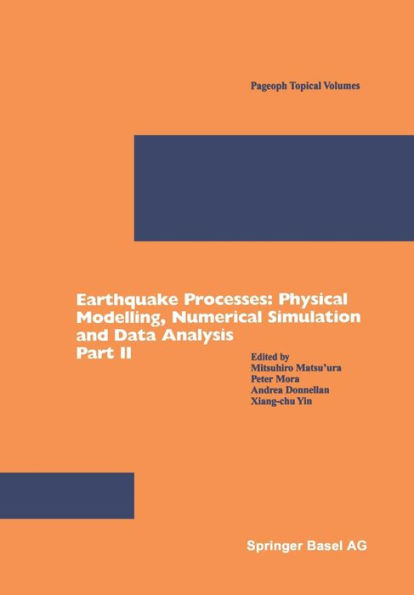5
1

Earthquake Processes: Physical Modelling, Numerical Simulation and Data Analysis Part II
367
by Mitsuhiro Matsu'ura (Editor), Peter Mora (Editor), Andrea Donnellan (Editor), Xiang-chu Yin (Editor)
Mitsuhiro Matsu'ura

Earthquake Processes: Physical Modelling, Numerical Simulation and Data Analysis Part II
367
by Mitsuhiro Matsu'ura (Editor), Peter Mora (Editor), Andrea Donnellan (Editor), Xiang-chu Yin (Editor)
Mitsuhiro Matsu'ura
Paperback(2002)
$54.99
-
PICK UP IN STORECheck Availability at Nearby Stores
Available within 2 business hours
Related collections and offers
54.99
In Stock
Overview
In the last decade of the 20th century, there has been great progress in the physics of earthquake generation; that is, the introduction of laboratory-based fault constitutive laws as a basic equation governing earthquake rupture, quantitative description of tectonic loading driven by plate motion, and a microscopic approach to study fault zone processes. The fault constitutive law plays the role of an interface between microscopic processes in fault zones and macroscopic processes of a fault system, and the plate motion connects diverse crustal activities with mantle dynamics. An ambitious challenge for us is to develop realistic computer simulation models for the complete earthquake process on the basis of microphysics in fault zones and macro-dynamics in the crust-mantle system. Recent advances in high performance computer technology and numerical simulation methodology are bringing this vision within reach. The book consists of two parts and presents a cross-section of cutting-edge research in the field of computational earthquake physics. Part I includes works on microphysics of rupture and fault constitutive laws, and dynamic rupture, wave propagation and strong ground motion. Part II covers earthquake cycles, crustal deformation, plate dynamics, and seismicity change and its physical interpretation. Topics in Part II range from the 3-D simulations of earthquake generation cycles and interseismic crustal deformation associated with plate subduction to the development of new methods for analyzing geophysical and geodetical data and new simulation algorithms for large amplitude folding and mantle convection with viscoelastic/brittle lithosphere, as well as a theoretical study of accelerated seismic release on heterogeneous faults, simulation of long-range automaton models of earthquakes, and various approaches to earthquake predicition based on underlying physical and/or statistical models for seismicity change.

Product Details
| ISBN-13: | 9783764369163 |
|---|---|
| Publisher: | Birkhäuser Basel |
| Publication date: | 11/11/2002 |
| Series: | Pageoph Topical Volumes |
| Edition description: | 2002 |
| Pages: | 367 |
| Product dimensions: | 0.00(w) x 0.00(h) x 0.30(d) |
Table of Contents
A. Earthquake Cycles, Crustal Deformation and Plate Dynamics.- 3-D Simulation of Earthquake Generation Cycles and Evolution of Fault Constitutive Properties.- Interplate Earthquake Fault Slip During Periodic Earthquake Cycles in a Viscoelastic Medium at a Subduction Zone.- Development of a Finite Element Simulator for Crustal Deformation with Large Fault Slipping.- 3-D Viscoelastic FEM Modeling of Crustal Deformation in Northeast Japan.- Combined GPS and InSAR Models of Postseismic Deformation from the Northridge Earthquake.- A Hidden Markov Model Based Tool for Geophysical Data Exploration.- Geophysical Applications of Multidimensional Filtering with Wavelets.- Large Amplitude Folding in Finely Layered Viscoelastic Rock Structures.- Mantle Convection Modeling with Viscoelastic/Brittle Lithosphere: Numerical Methodology and Plate Tectonic Modeling.- GEM Plate Boundary Simulations for the Plate Boundary Observatory: A Program for Understanding the Physics of Earthquakes on Complex Fault Networks via Observations, Theory and Numerical Simulation.- B. Seismicity Change and its Physical Interpretation.- Accelerated Seismic Release and Related Aspects of Seismicity Patterns on Earthquake Faults.- Stress Correlation Function Evolution in Lattice Solid Elasto-dynamic Models of Shear and Fracture Zones and Earthquake Prediction.- Pattern Dynamics and Forecast Methods in Seismically Active Regions.- Long-range Automaton Models of Earthquakes: Power-law Accelerations, Correlation Evolution, and Mode-switching.- Critical Sensitivity and Trans-scale Fluctuations in Catastrophic Rupture.- Load—Unload Response Ratio and Accelerating Moment/Energy Release Critical Region Scaling and Earthquake Prediction.- Simulation of the Load—Unload Response Ratio and Critical Sensitivity in the Lattice Solid Model.From the B&N Reads Blog
Page 1 of
